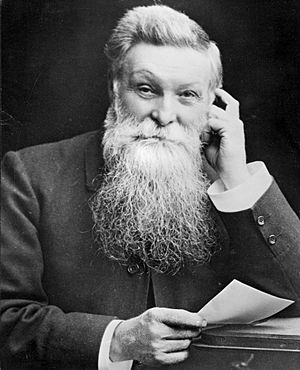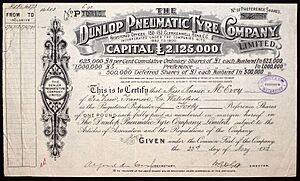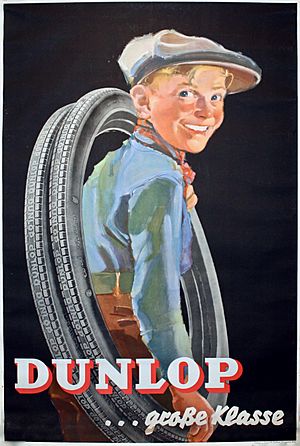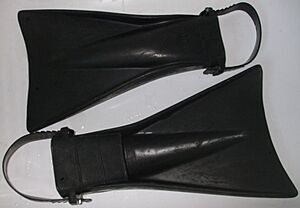Dunlop Rubber facts for kids
 |
|
|
Formerly
|
List
|
|---|---|
| Industry | Automotive, sports equipment |
| Fate | Acquired by BTR plc in 1985, becoming a brand, then operated by different companies worldwide after BTR folded |
| Successor | BTR plc |
| Founded | 18 November 1889 |
| Founders | Harvey du Cros and John Boyd Dunlop |
| Defunct | 1985 |
| Headquarters |
Fort Dunlop, Erdington, Birmingham
,
|
|
Key people
|
Eric Geddes (Director, 1922–24) |
| Products | |
| Brands | Dunlopillo Aquafort |
|
Number of employees
|
102,000 (1970) |
| Parent | Goodyear and Sumitomo |
| Divisions | Dunlop Tyres Dunlop Sport |
| Subsidiaries | Slazenger (1959–85) George Angus Ltd. (1968–85) |
Dunlop Ltd. was a famous British company that made many products from natural rubber. It was started in 1889 by Harvey du Cros. He worked with John Boyd Dunlop, who had invented and improved the first pneumatic tyre. This is the type of tyre filled with air that we still use today!
Dunlop became one of the biggest British companies and one of the first to operate in many countries. However, in the 1970s, the company struggled to keep up with new changes in the market. For example, new, stronger radial tyres became popular. Because of money problems, another company called BTR bought Dunlop in 1985. Since then, different companies around the world own parts of the Dunlop brand.
Contents
How Dunlop Started and Grew (to 1921)
The First Pneumatic Tyre
In 1888, John Boyd Dunlop, a vet from Scotland living in Ireland, came up with the idea of the pneumatic tyre. This was a big deal! A cyclist named Willie Hume showed how great these new tyres were by winning many races.
To make and sell these tyres, a company called "Pneumatic Tyre and Booth's Cycle Agency Co. Ltd" was formed in 1889. Harvey du Cros helped set it up. John Boyd Dunlop himself didn't think his invention would be a huge success, so he sold his rights to William Bowden, a cycle agent. At first, J. B. Dunlop owned a small part of the new company.
Expanding the Tyre Business
The late 1880s were exciting times for bicycles, especially with John Kemp Starley's new "safety bicycles." Pneumatic Tyre started making bicycle tyres in Belfast in late 1890. They quickly grew to meet the high demand.
However, in 1890, they found out that J. B. Dunlop's patent wasn't the first. Someone else, Robert William Thomson, had already patented a pneumatic tyre way back in 1845! J. B. Dunlop and Harvey du Cros worked hard to solve this problem. They hired an inventor and bought other patents to protect their business.
In the early 1890s, Pneumatic Tyre opened branches in Europe and North America. They sent four of du Cros's six sons to help manage these new international businesses. They built factories in other countries because they needed to make tyres where they sold them to keep their patent rights. They also worked with local bike companies like Clement Cycles in France.
In 1893, the company moved its main tyre making from Belfast and Dublin to Coventry, which was the centre of the British bicycle industry. This was partly because people in Dublin complained about the smell from the rubber factories. The company soon also started working in Birmingham.
Becoming Dunlop Rubber
J. B. Dunlop left the company in 1895 and sold most of his shares. In 1896, Harvey Du Cros convinced the company to sell to a financier named Ernest Terah Hooley. Hooley then quickly sold the business again for a lot more money, renaming it the Dunlop Pneumatic Tyre Company.
From the late 1890s, Dunlop Pneumatic Tyre started making its own rubber parts instead of buying them from other companies. In 1901, they used their power to rename "Rubber Tyre Manufacturing" to "Dunlop Rubber."
After 1900, Dunlop started making more than just bicycle tyres. They made their first car tyre in 1900. In 1906, they built a factory for car wheels. By 1910, Dunlop had developed its first aeroplane tyre and even a golf ball!
Between 1904 and 1909, Dunlop's French branch lost money because other European companies like Michelin (France) and Continental (Germany) were doing better in the car tyre market. To fix this, the British Dunlop company fully bought its French and German branches.
Merging Companies and Growth
In 1912, Dunlop Pneumatic Tyre joined forces with Dunlop Rubber. This helped them save money and made their business clearer.
By 1917, the company owned huge rubber plantations in Ceylon and Malaya to get their own rubber. In 1916, they started building the Fort Dunlop site, a massive factory covering 400 acres. By 1918, Dunlop was one of the biggest manufacturing companies in Britain and the only large tyre maker.
However, in 1921, the company faced big financial problems. The price of rubber dropped, and there were issues with tyre quality. The company lost a lot of money. Luckily, a financier named Frederick Szarvasy helped save the company. Sir Eric Geddes became the new chairman.
Dunlop's New Products (1920s-1930s)
Expanding Beyond Tyres
From 1924, Sir Eric Geddes started to make Dunlop a more diverse company. They began making tennis balls in 1924. In 1925, they bought F. A. Davis, a company that knew how to make tennis rackets. In 1926, they bought Charles Macintosh, and the Dunlop name was put on shoes and clothes. By 1928, only 72% of their sales were from tyres, compared to 90% in 1920.
In the late 1920s, Dunlop had factories in many countries, including the US, Canada, France, Germany, South Africa, Australia, India, and Japan. By 1930, Dunlop had the same amount of market share as its main competitor, Michelin, in France.
Innovative Products and Global Reach
In 1929, Dunlop patented Dunlopillo latex foam, which was a new type of soft rubber foam. They started making Dunlopillo products in 1933. By 1930, Dunlop was the eighth largest public company in Britain.
Dunlop grew a lot internationally between the two World Wars. They built factories in Ireland, South Africa, and India in the 1930s. In 1932, the famous Dunlop bridge was built over the Circuit De La Sarthe, where the Le Mans 24-hour race takes place.
By 1939, Dunlop was one of the biggest British companies operating worldwide. During the 1930s, Dunlop also designed and made joysticks for British and other Allied aircraft, especially for the Supermarine Spitfire planes used in World War II and the Battle of Britain.
After the War
By 1946, Dunlop had 70,000 employees and sold products in almost every country. In 1948, Dunlop invented the self-sealing tyre, which helped prevent blowouts. In the early 1950s, Dunlop developed Maxaret, the first anti-lock braking system (ABS), which helps cars stop safely.
By 1955, Dunlop made almost half of all tyres sold in the UK. However, a report found that Dunlop and other big tyre companies were fixing prices. This had to change, and Dunlop's share of the market went down.
In 1958, Dunlop bought another British company called John Bull Rubber. Throughout the 1950s, Dunlop also had factories in Brazil and New Zealand.
Dunlop also made a range of underwater swimming gear called Dunlop Aquafort. This included dry suits, wetsuits, weight belts, snorkels, diving masks, and swimming fins. These were made from the mid-1950s to the early 1960s.
A big reason for Dunlop's decline was a decision in the early 1960s. They chose to make cheaper textile radial tyres instead of the stronger steel-belted radial tyres. This meant they lost customers to companies like Michelin, who made the steel-belted ones.
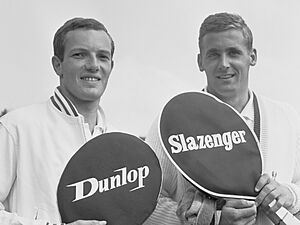
In 1967, the company changed its name from "Dunlop Rubber Company Ltd" to "Dunlop Ltd" because they made so many different things, not just rubber. At this time, about 60% of their sales came from outside the UK, and tyres made up 60% of the company's total sales.
In 1968, Dunlop bought George Angus Ltd, a company known for fire hoses and firefighting equipment. By the late 1960s, Dunlop was the 35th largest company in the world outside the United States. In 1970, Dunlop had 102,000 employees!
In 1971, Dunlop joined with Pirelli from Italy to become the world's third-largest tyre company. However, this partnership didn't work out well, and they separated in 1981. The decline of the British car industry from 1972 onwards and the 1973 oil crisis also hurt Dunlop's main business.
What Happened to Dunlop?
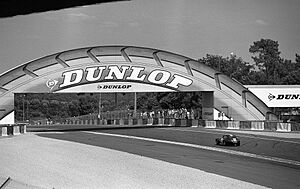
Because of strong competition and the failed partnership with Pirelli, Dunlop had a lot of debt. In 1983, Dunlop sold its European tyre business to a Japanese company called Sumitomo Rubber Industries Ltd. In 1984, they sold their remaining tyre factories in New Zealand and India.
Finally, in 1985, the company was bought by BTR plc. BTR then started selling off different parts of Dunlop. For example, in 1996, they sold Dunlop Slazenger (which made sports equipment) to its managers.
In 1996, Dunlop Aircraft Tyres Ltd, which made aeroplane tyres, was sold. In 1998, BTR sold its aerospace group, including Dunlop Aviation, to another company. This company, now called Dunlop Holdings Ltd, is the original English company that started in 1896.
In 1998, BTR also sold its share of the South African Dunlop company. The tyre part of that business was bought by Apollo Tyres of India in 2006. Apollo Tyres later sold most of its South African operations, including the Dunlop Tyre trademark rights in Africa, back to Sumitomo Rubber Industries in 2013.
Dunlop Tyres Today
Since 1985, Sumitomo Rubber Industries has sold road vehicle tyres under the Dunlop brand. In 1999, Sumitomo RI and Goodyear Tire and Rubber Company from the US formed a joint venture. Goodyear got the Dunlop tyre businesses in Europe and the US, while Sumitomo RI continued to sell Dunlop tyres in other countries.
The Dunlop Tyres company in South Africa was bought by the Indian company Apollo Tyres in 2007. But in 2013, Apollo Tyres sold most of its South African business, including a tyre plant, to Sumitomo RI. Sumitomo RI also gained the rights to the Dunlop brand in 32 African countries. Since 2018, Sumitomo RI has invested a lot in the Ladysmith plant, making it much bigger.
See also
- Dunlop (brands)


